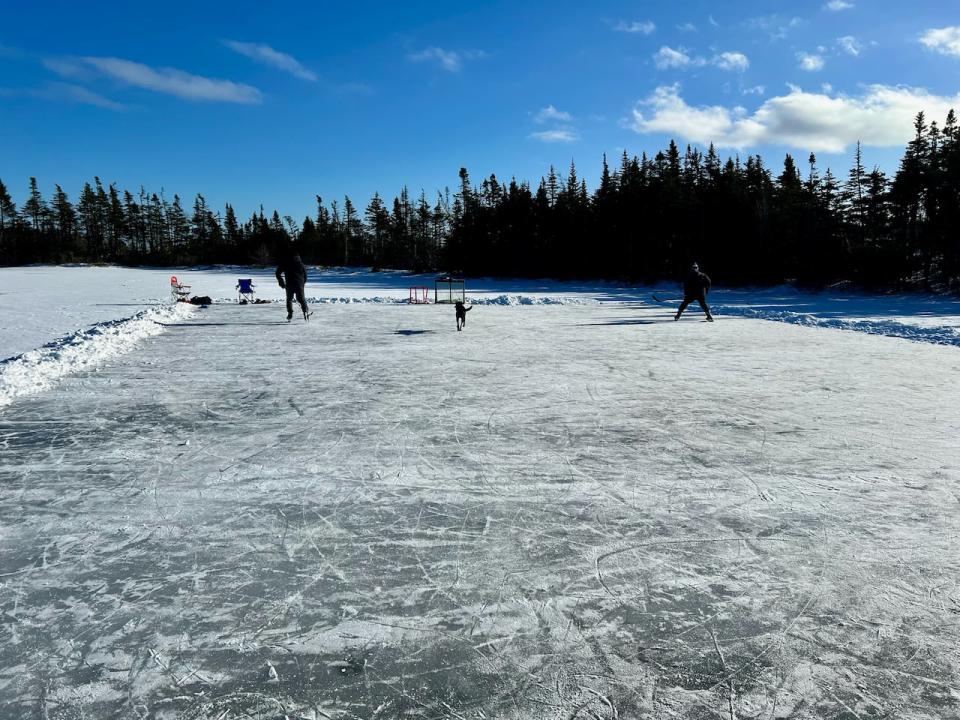As skaters take to the frozen ponds, an outdoor expert shares safety tips for anyone on ice this winter


Noah Brace, left, and Ryan Russell were having fun playing a game of ball hockey on some ice in Flatrock on Saturday. (William Ping/CBC)
With the winter now in full effect, skaters like Noah Brace and Ryan Russell are having lots of fun outside on the ice.
"The conditions are great, so you got to get out and take advantage of it, and the ice is plenty thick, so we're just enjoying the day," said Brace on Saturday, while taking a break from a game of ball hockey on a pond in Flatrock.
"You know what the Avalon is like, normally it's rainy and icy anyways, so it's not very often you get the right conditions."
Russell says about 10 to 15 people got together on the pond for a game of hockey.
"It's a good time," he said.
Brace and Russell happened upon the pond last weekend while driving by.
"We saw a couple of b'ys playing out here," Russell said. "We stopped and talked to them and then we got a game going the next day."
Another man on the pond tested the ice to make sure it was safe.
"There was a fellow with a hatchet here and he drove a hole down through it," Brace said. "There's about 8 to 10 inches of ice here."
Minimum 4 inches of ice needed
For people looking to join in on the outdoor fun, Barry Fordham, vice-president of public education with the Newfoundland and Labrador branch of the Lifesaving Society, has some more tips on how to make sure the ice is safe.
In addition to the hatchet method, Fordham said there are a number of ways to test the thickness of the ice.
"An ice auger, a chisel or… an electric drill to just pop the hole down through and measure the ice," Fordham said. "The minimum ice safety is four inches of ice. However, personally speaking, I prefer six inches plus to safely walk on."
He said the colour of the ice is also important.
"The blue, white ice surface is usually the denser ice, whereas gray or darker brown is unsafe."
"Let someone know where you're going and when you're going to return," Fordham said. "Travel with friends and monitor the weather as you go."

Barry Fordham, vice-president of public education with the Newfoundland and Labrador branch of the Lifesaving Society, says wearing a life jacket can make a huge difference in ice safety. (Ryan Cooke/CBC)
Fordham said extra caution is also required near inlets and outlets of water, as that's where ice erodes quickly.
"Make sure you're checking ice depth at all times," he said.
Fordham also suggests remembering the 1-10-1 principle.
"The first one stands for the gasp. When you go through the ice, the water is so cold that you get a gasp reflex that could last up to a minute. If you're underwater and you gasp, that could take water into your lungs.… The 10 represents how you have 10 minutes left of functioning ability of your hands and feet before you start to go numb," he said.
"The last one represents how there's one hour before hypothermia sets in, and then you're in big trouble."

Noah Brace and Ryan Russell are playing ball hockey with a dog on ice in Flatrock. (William Ping/CBC)
Another big tip from Fordham is the use of a life-jacket or personal floatation device (PFD). He said wearing one is a huge help in the event of a person falling through ice.
The life jacket will then help a skater bob to the surface faster and therefore inhale less water during the gasp.
"It also provides you with buoyancy so you don't have to be so worried about trying to stay afloat... then you can focus on the more important thing which is getting your elbows up on the ice, kicking your feet to propel yourself forward to get out using ice picks."
"Once you're out then roll away," Fordham said. "Move back to the ATV, the Ski-Doo or whatever vehicle you have. If you're in the woods aways, then you should concentrate on getting a fire going as fast and as big as possible to get warmed up and dried out."
Though there are places where people are ice skating safely, Fordham said the ice is still not yet safe in many parts of the province.
"There are areas in the province now where the ice is safe and there are areas where the ice is not safe. So definitely most importantly, you should check the ice as you go out further on it."
Download our free CBC News app to sign up for push alerts for CBC Newfoundland and Labrador. Click here to visit our landing page.

 Yahoo News
Yahoo News 
